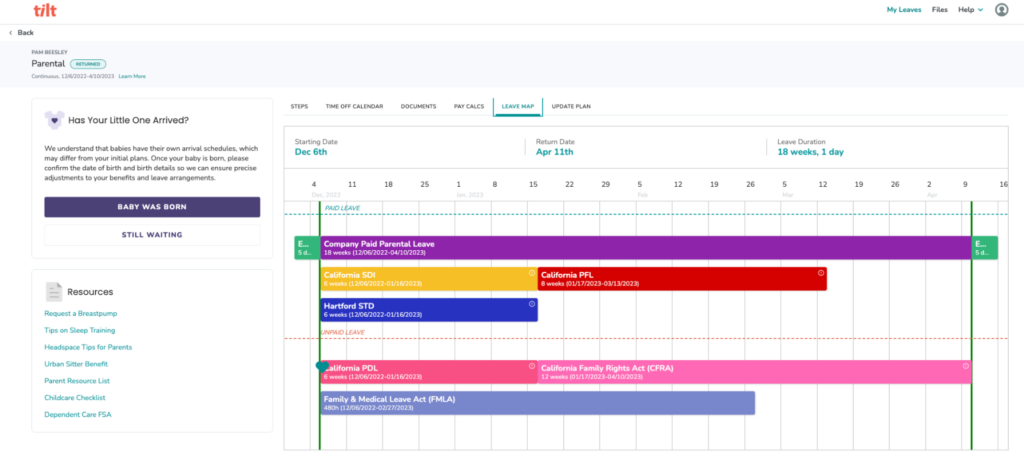Parental Leave (n): The magical moment when businesses realize that babies are born, and that employees need to spend time recovering (physically and emotionally) and to bond with them.
Of course, the definition of parental leave is a little more complicated than that. Your company policy might have different requirements for birthing and non-birthing parents, for example, and the policy may or may not be providing benefits to employees seeking to adopt, foster or seek other pathways to parenthood.
Additionally, there are federal and state programs that may offer varying types of support for your new-parent employees. While FMLA provides eligible employees with job protection for the birth of a child or placement of a child with the employee for adoption or foster care, state programs like Colorado’s new FAMLI program provide paid leave (and job protection if the employee has been working for the employer for 180 days) to care for a new child, including adopted and fostered children.
While FMLA and FAMLI are only a few of the many programs offered across the country (with more on the way) for parental leave, your organization is responsible for adhering to applicable laws and regulations and complying with employee notice requirements.
Going Beyond Parental Leave of Absence Policies
Many organizations today tout their family-friendly policies, and rightfully so, proudly offering paid parental leave as a testament to their commitment to work-life balance and employee well-being. While paid parental leave is undoubtedly a crucial and positive step toward supporting working parents, it often represents just the tip of the iceberg when it comes to comprehensive leave policies.
Unfortunately, many organizations tend to stop at parental leave, failing to recognize the diverse needs and challenges that their employees face throughout their careers. Further still, employees are often unaware that federal and state programs provide support beyond parental leave as well.
Sticking with the two examples above, FMLA also provides eligible employees with job protection for:
- A serious health condition that makes the employee unable to work
- The care of a child, spouse or parent with a serious health condition
- Reasons related to a family member’s service in the military, including
- Qualifying exigency leave – Leave for certain reasons related to a family member’s foreign deployment, and
- Military caregiver leave – leave when a family member is a current servicemember or recent veteran with a serious injury or illness.
In addition to parental leave, Colorado’s FAMLI program provides eligible employees paid leave for:
- Care for themselves, if they have a serious health condition
- Care for a family member’s* serious health condition
- Make arrangements for a family member’s military deployment
- Address the immediate safety needs and impact of domestic violence and/or sexual assault.
*To add to the complexity, the term “family member” is defined more broadly under FAMLI than FMLA. Under FAMLI, it includes an employee’s child, parent, spouse, domestic
partner, grandparent, grandchild, sibling, or someone with whom they have a significant personal bond.
Individuals require time off for various reasons beyond becoming parents, such as personal health, caring for aging parents, pursuing education, or dealing with unexpected emergencies. This limited focus on parental leave in your organization’s rhetoric and policies can leave a significant gap in employee education and support.
The failure to address these broader leave needs reflects a one-size-fits-all approach that neglects the unique circumstances and requirements of a diverse workforce.
The Complexity of Comprehensive Leave Policies
Managing and administering comprehensive leave policies are vital to any organization hoping to thrive in the modern business ecosystem. Every organization has a different employee population with different needs and different budgets available to allocate toward supporting employees on leave.
Let’s take Colorado’s FAMLI plan again and address a critical component of the employee benefit we have yet to discuss; the amount of paid leave employees are entitled to. An employee’s weekly FAMLI benefits are currently capped at $1100 a week, meaning that if you want to make your employees whole (a strong talent acquisition position), your organization’s parental leave policy would need to do more than just authorize time off, you’d need to calculate and cover the pay difference. For every leave.
This means that your employees may have multiple leave policies operating for them at the same time. Here’s a visual from Tilt’s platform that might help explain it better.

In this one very common example of a California birthing parental leave, Pam Beesley is receiving paid benefits via her organization’s Paid Parental Leave policy, California State Disability Insurance, and Short Term Disability benefits from the insurance carrier The Hartford, followed by California Paid Family Leave benefits. On top of that, Pam is receiving job protection from FMLA, California’s Pregnancy Disability Leave law and the California Family Rights Act (CFRA).
It’s important to underscore just how complicated parental leave is to manage on its own, adding different leave types furthers the complexity for the following reasons:
- Your different leave types may have different requirements and offer different benefits, which should be communicated clearly across your organization.
- Leaves should be administered consistently, no matter the leave type, to avoid risk of employees claiming favoritism or discrimination.
- Your benefits should cover leave scenarios that accommodate the specific needs of your employee population, and different employees have different needs.
- The more leave situations you cover with company policies, the more complex your tracking and record-keeping becomes.
- Complex leave laws may require you to seek legal expertise as you design and administer comprehensive company leave policies.
- Leaves of absence are typically a very human experience, and the journey could go sideways at any time, for example, a leave may start under your parental leave policy but may need to transition to your bereavement leave policy in the event of unfortunate circumstances.
Breaking Down Your Leave Policies
When developing your leave policies, it’s important to get input from your employee population as to what policies matter to them. Your policies should reflect the demographics and needs of the people in your organization first and foremost.
From there, it’s important to educate your managers and employees on the policies you offer, which are paid and which are unpaid, and also make it clear if there are Federal, state, or local programs that offer leave of absence support to eligible employees. It’s also vital to have clear policies that are easily accessible (like an employee handbook or your organization’s intranet) and clearly explain who is eligible, any documentation requirements, how long they can be on leave, etc…
Here are some policies you might want to consider adding to your existing policies if you don’t include them already:
Paid Family and Medical Leave
Parental Leave
Personal Leave
Bereavement Leave
Mental Health Leave
Miscarriage Leave
Military Leave
Domestic Violence Leave
Jury Duty Leave
Paid Adoption Leave
You’ll need to have a clear process in place should policies overlap with one another so that employees, managers and payroll understand exactly what job protections are in play, how much your employees are getting paid and from which programs, and when said programs and policies begin and end.
In the end, the more robust your leave offerings the more support you’re providing your employees, but also the more complexities you’re introducing into your leave of absence management process.
About Tilt
Tilt is leading the charge in all things leave of absence management through easy-to-use tech and human touch. Since 2017, our proprietary platform and Empathy Warriors have been helping customers make leave not suck by eliminating administrative burdens, keeping companies compliant, and providing a truly positive and supportive leave of absence experience for their people.







